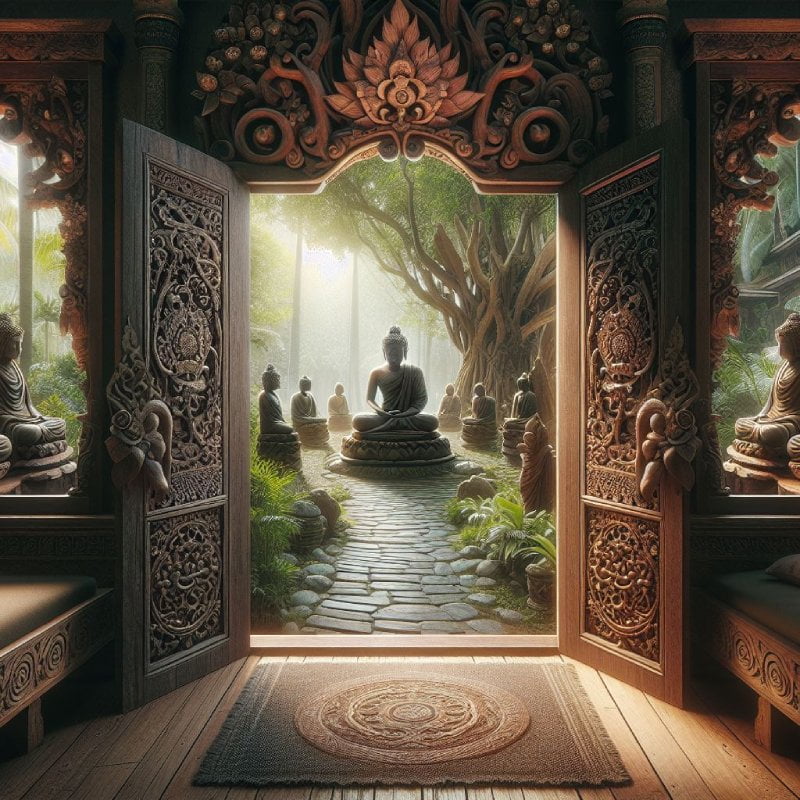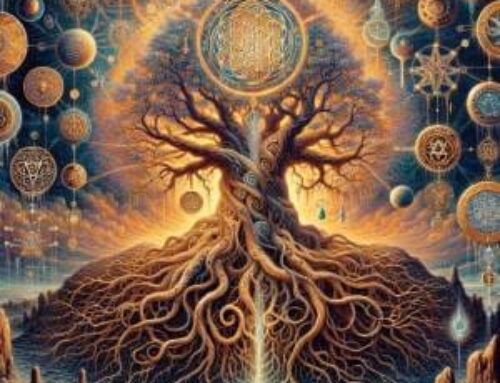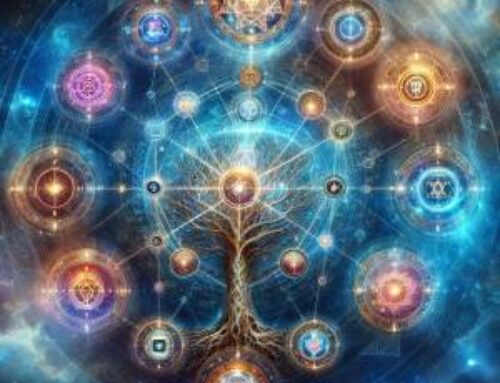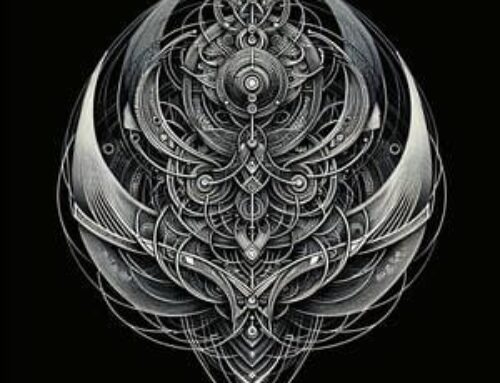Contents
Introduction to Kabbalah and Buddhism
In the arcane corridors of spiritual tradition, where whispers of ancient wisdom echo through the ages, the teachings of Kabbalah and Buddhism stand as monumental pillars. Each, rooted in profound metaphysical landscapes, offers seekers esoteric maps to navigate the ethereal realms of enlightenment. As we unfurl the scrolls of “Kabbalah and Buddhism,” we encounter not just paths but profound dialogues between the soul and the cosmos.

Kabbalah, a mystical exploration beyond the physical veil, charts the divine blueprint through the enigmatic Tree of Life—a cosmic schema embodying the universe’s quintessential forces. Buddhism, with its disciplined pursuit of the Middle Way, offers a methodical extinguishing of suffering through mindful awakening and ethical purity. These traditions, though sprung from diverse spiritual soils, converge in their mystical topographies, charting courses to transcendent truths and sublime liberation.
This discourse seeks to illumine the hidden symmetries and shared quests of “Kabbalah and Buddhism.” Through a tapestry of their sacred symbols, meditative disciplines, and philosophical underpinnings, we will traverse the landscapes of the spirit to uncover the universal quest for enlightenment that binds these ancient wisdoms. As we delve into their profound teachings, let us allow the light of understanding to guide us through the intertwined paths of mystical realization.
Foundational Philosophies
Foundational Philosophies of Kabbalah and Buddhism
Buddhism has gained popularity in Western traditions, despite its roots in deep Eastern philosophy, which may not fully align with the Western mindset. Embracing an Eastern path might appear modern, yet it does not guarantee that individuals immersed in Western lifestyles will find success on a journey so divergent from their cultural bedrock. In contrast, Kabbalah is emblematically a Western path, inherently intertwined with the mindset and lifestyle of Western society. It stands as one of the oldest spiritual traditions in human history, built upon a steadfast foundation, with the aspiration to catalyze humanity’s spiritual evolution to its next echelon.
Kabbalistic Teachings
Kabbalah, an esoteric interpretation of mystical traditions, presents the universe as a complex but highly structured system of divine emanations. This structure is most prominently illustrated through the Sefirot (Sephiroth) of the Tree of Life, which maps out the dynamic flow of divine energy from the ineffable Above to the tangible Below. Each Sefirah (Sephirah) represents attributes of God, and their configuration elucidates the process by which the cosmos is continually created, sustained, and perfected.
Buddhist Wisdom
Buddhism, founded on the teachings of Siddhartha Gautama, or the Buddha, articulates a path to liberation through the understanding of Four Noble Truths. These truths diagnose the human condition as one bound by suffering (Dukkha), which is caused by desire (Tanha) and ignorance (Avijja). Liberation (Nirvana) is achievable through adherence to the Eightfold Path, a disciplined practice that integrates ethical conduct, mental discipline, and wisdom.
Intersecting Philosophies
While Kabbalah elucidates a vertical schema of divine-human interaction, Buddhism offers a horizontal plan for ethical living and mental purification. Both paths demand a deep inner transformation by understanding the self and its relation to the cosmos. Kabbalah uses meditative practices to ascend the Tree of Life and experience divine union, whereas Buddhism emphasizes mindfulness and ethical living as methodologies to extinguish the self’s illusions and awaken to reality.
Symbols of the Soul
Decoding the Esoteric Symbols of Kabbalah and Buddhism
In the mystical realms where the profound interplay of symbolism and spirituality unfolds, Kabbalah and Buddhism stand as bastions of esoteric knowledge. Through their rich tapestries of symbols, these traditions offer more than mere religious iconography; they provide keys to unlocking the deeper mysteries of the universe and the human psyche.
Kabbalistic Symbols
At the heart of Kabbalistic wisdom lies the Tree of Life, a complex yet elegant arrangement of ten spheres or Sefirot, connected by twenty-two paths. Each sphere signifies a specific divine attribute or emanation, collectively depicting the dynamic process of creation and the human soul’s potential for divine return. This symbol is not only a metaphysical blueprint of the cosmos but also a meditative tool, guiding initiates through the veils of reality to higher states of consciousness.
Buddhist Symbols
Buddhism, with its rich symbolic language, offers the Wheel of Dharma as a central emblem of spiritual doctrine. Each of the wheel’s eight spokes points to a part of the Noble Eightfold Path, a prescription for moral and mental development that leads to the extinguishing of suffering and rebirth. The Lotus Flower, emerging pristine from muddy waters, captures the essence of Buddhist teachings on purity and transformation. It symbolizes the potential of sentient beings to rise through suffering and attain enlightenment, echoing the Buddha’s journey from attachment to liberation.
Synthesis of Symbolic Wisdom
The Tree of Life and the Wheel of Dharma, though culturally and philosophically distinct, are complementary symbols. Each serves as a spiritual compass, guiding followers through the complexities of existence toward ultimate truths. The Kabbalistic tree intricately details the flow of divine energy and its manifestation in the physical world, offering a ladder to the divine, while the Buddhist wheel simplifies the path to enlightenment into practical steps that balance the spiritual and mundane aspects of life.
Mystical Experiences and Their Interpretations
The Esoteric Encounters of Kabbalah and Buddhism
In the silent spaces where the mind dissolves, the mystical experiences in Kabbalah and Buddhism offer profound encounters with the divine and the self. These traditions, rich with esoteric practices, provide not only pathways to transcendence but also frameworks for interpreting these profound experiences.
Mystical Practices in Kabbalah
Kabbalah invites its adherents to ascend the mystical Tree of Life, each Sefirot not only a portal to divine attributes but also a stage in the soul’s journey towards unity with the Ain Soph (the Infinite). The practice of Kabbalistic meditation involves contemplative techniques that visualize the Sefirotic tree, drawing down divine light through the sefirot and integrating these energies within the practitioner’s spiritual and physical makeup. This transformative process is seen as a way to rectify the soul’s imperfections and achieve divine alignment. The Kabbalist strives for a complete transformation to integrate higher consciousness into everyday life and to transform his vehicles to make this experience possible.
Mystical Insights in Buddhism
Buddhism’s mystical path is often marked by deep meditation and mindfulness practices, leading to experiences of Sunyata (emptiness) where all dualistic perceptions are transcended. This state is not a nihilistic void, but a profound realization of the non-separation of all phenomena. Practitioners experience No-Self (Anatta) as a liberation from egoic constraints, leading to profound peace and enlightenment. The Pali canon describes these experiences as openings to Nirvana, where the fires of desire, aversion, and delusion are extinguished.
Interpreting Mystical States
Both Kabbalah and Buddhism see these mystical experiences not as final destinations but as integral steps on the path to greater spiritual maturity and understanding. In Kabbalah, the integration of divine light through initiations, rituals, meditative practices enhances one’s ability to act in the world with wisdom and compassion. In Buddhism, insights gained from experiences of emptiness inform ethical living and compassionate action, embodying the Bodhisattva ideal.
Conclusion
As we have traversed the profound realms of “Kabbalah and Buddhism,” we have explored their foundational philosophies, symbolic systems, mystical experiences, and the transformative journey toward enlightenment. These venerable traditions, though arising from distinct cultural and spiritual soils, each chart a course toward profound self-understanding and cosmic realization. Both Kabbalah and Buddhism not only challenge the practitioner to transcend the mundane but also to reforge their identity in the crucible of spiritual wisdom.
Kabbalah and Buddhism provide unique yet complementary modalities for spiritual exploration and growth. Kabbalah’s detailed map of the divine emanations through the Tree of Life offers a mystical blueprint to the cosmos, inviting an ascent to the divine, while Buddhism’s disciplined path through the Eightfold Path emphasizes ethical living and mental cultivation as means to dissolve the self in Nirvana. Both paths underscore a profound integration of self with the universal, a journey from the illusion of separateness to the reality of the whole.
Encouraging Further Engagement
For those drawn to the esoteric and the eternal, the study and practice of Kabbalah can offer unparalleled insight and transformation. Through the contemplative ascent of the Tree of Life, seekers are invited to explore these timeless wisdoms to enrich their spiritual journey. Join the Hermetic Academy to further explore this mystical tradition.
FAQ – Kabbalah and Buddhism
1. What are the main goals of Kabbalah and Buddhism?
A: Both Kabbalah and Buddhism aim for enlightenment, but their approaches differ. Kabbalah focuses on the mystical ascent through the Sefirot of the Tree of Life to achieve unity with the divine essence, known as Ain Soph (Ein Sof). Buddhism seeks enlightenment through the realization of Nirvana, which involves extinguishing the three fires of desire, aversion, and ignorance, culminating in a profound understanding of No-Self and interconnectedness.
2. How do the symbols in Kabbalah and Buddhism guide spiritual practice?
A: In Kabbalah, the Tree of Life serves as a complex framework for understanding the universe’s divine architecture and the soul’s ascent to enlightenment. In Buddhism, the Wheel of Dharma, including the Eightfold Path, symbolizes the principles leading to the cessation of suffering. Both sets of symbols provide followers with meditative and contemplative paths designed to deepen understanding and spiritual experience.
3.What are mystical experiences like in Kabbalah and Buddhism?
A: Mystical experiences in Kabbalah involve divine communion through the Sefirot and achieving higher consciousness and unity with the divine. In Buddhism, mystical experiences often relate to profound realizations of emptiness (Sunyata) and the transient nature of existence, leading to insights into the universal truth of interconnectedness and No-Self.
4. Where can one learn more about Kabbalah and Buddhism?
A: To deepen your understanding the Hermetic Academy offers a wealth of resources and a platform for study, practice and initiation.
References:
(1) Eliphas, L. (1854). Dogme et Rituel de la Haute Magie. Paris.
(2) Eliphas, L. (1854). Dogme et Rituel de la Haute Magie. Paris.
(3) Fasching, W. (2008). Consciousness, self-consciousness, and meditation. Phenomenology and the Cognitive Sciences, 7, 463-483. https://doi.org/10.1007/S11097-008-9090-6.
(4) Rubenstein, E. (2020). The Tree of Life: The Kabbalah of Immortality. Hermetic World, Paphos.





